Subulter
Houses within 15km of this house
Displaying 129 houses.
Houses within 15km of Subulter
Displaying 129 houses.
| House name | Description | |
|---|---|---|
| Longueville House | Longueville House was the seat of the Longfield family, built in 1720. Wilson, writing in 1786, refers to it as the seat of John Longfield. In the 1850s it was valued at £56 and held by Richard Longfield from the representatives of Charles P. Coote with a demesne of 312 acres. The Longfields sold Longueville to Senator William O'Callaghan in 1938. The Irish Tourist Association survey of the 1940s claims that the original lands were taken from the O'Callaghans after the 1641 rebellion and granted to Sir Nicholas Purdon. Longueville is now a country house hotel. |

|
| Newmarket House | Smith refers to the "stately house of Boyle Aldworth" on the south east side of the town in 1750. Lewis refers to Mr Aldworth's lodge in Newmarket. Newmarket was the seat of the Aldworth family held by Richard O. Aldworth in fee and valued at £56 in the mid 19th century. Valued at the same amount in 1906 it was the home of Major Richard Aldworth. In 1943 the Irish Tourist Association Survey mentions that the family went to live in England during the Anglo-Irish war and that the house was occupied by Crown forces and later by the Free State Army. According to the survey it was bought by the Sisters of St. Joseph in 1927. Newmarket House is still extant and now known as the James O'Keeffe Memorial Centre. |

|
| Greenfield | In 1814 occupied by William Allen and at the time of Griffith's Valuation Michael Boyan was resident. He held the property valued at £10+ from Richard O. Aldworth. Colonel Grove White writes that Boyan bought Greenfield from the Allens in 1840 in the Court of Chancery and that he made the house larger. Michael Boyan of Greenfield, Kanturk, owned 570 acres in county Cork in the 1870s. This house is extant and occupied. | |
| Liscongill | Occupied by William Allen at the time of Griffith's Valuation and held from Richard O. Aldworth, valued at £20+. In 1943 the Irish Tourist Association Survey mentions that the house had been divided and was then occupied by the Angland and Moynihan families. It is no longer extant. | |
| Mount Keeffe | This house dates from the 1770s and was the home of the O'Keeffe family, occupied by Maurice O'Keeffe in 1814. The property was held from the Aldworths. Manus O'Keeffe was resident in the mid 19th century, when the buildings were valued at £14+. In 1943 the Irish Tourist Association Survey noted it as the home of the Guerin family. It is still extant and well maintained. |

|
| Lohort Castle | A 15th century tower house, restored by the Perceval family, Earls of Egmont, in the mid 18th century and inhabited by their agents. At the time of Griffith's Valuation held by the Earl in fee and valued at £27. Remodelled in 1876, the castle later became the home of Sir Timothy O'Brien, baronet, and in 1906 he was recorded as the occupier. The building was burnt in July 1921 just before the War of Independence ended when it was the residence of Sir Timothy O'Brien. It was partly restored. The Irish Tourist Authority Survey reported in 1944 that it was the residence of James McCabe who had purchased it in 1925. It is still inhabited and in 2011 it was advertised for sale. |
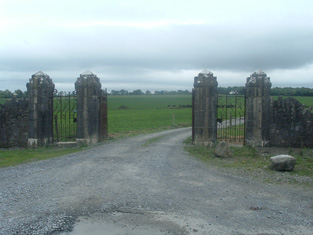
|
| Mill View | A five bay three storey house built about 1800, with some modern additions. At the time of Griffith's Valuation held by Sir Edward Tierney in fee, the buildings were valued at £19+. |

|
| Egmont Villa | A house occupied by Neptune Blood in the mid 19th century. He held the house valued at £19 from Sir Edward Tierney. Restored in the 1980s by Patrick Callaghan and still extant. | |
| Gortmore House | A late 18th century or early 19th century two storey house, the home of the Foote family in the 19th century. Occupied by Mr Thomas Clarke in 1814, by Edward Foote in 1837 and at the time of Griffith's Valuation. He held the house and demesne from Viscount Lismore. It is labelled Gortmore Castle on the 1st edition Ordnance Survey map but as Gortmore House on the later 25-inch edition of the 1890s. It is still extant. |

|
| Ballygiblin | This was the seat of the Becher baronets in the 19th century. Occupied in 1814 by Beecher Wrixon and in 1837 recorded by Lewis as "recently modernised" [William Morrison]. Sir William W. Beecher held Ballygiblin in fee at the time of Griffith's Valuation when it was valued at £52. The seat of Sir John Wrixon Becher in 1894 and still occupied by the Bechers in 1906. In 1944 the Irish Tourist Association Survey reported that it was owned by D.CMurphy and J. Lombard. The report contains detailed background to the Beecher family including the story of Lady Beecher, the actress, Elizabeth O'Neill. This house is now a ruin. |
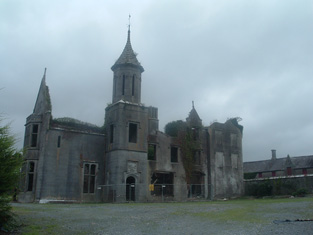
|
| Assolas | Built by the Reverend Francis Gore (died 1748) in the early 18th century and occupied by Philip Oliver circa 1750. This house was the home of the Wrixon family from 1774. Occupied by William Harris in 1814 and by Sir William Wrixon Becher in 1837. Richard Smith was resident in the mid 19th century, holding the property then valued at £25+ from Sir William W. Beecher. Owned and run as a guest house by the Bourke family until 2005. In 2022 it was offered for sale. |

|
| Churchtown House | Located on the Egmont estate Churchtown House was the residence of the Crofts family in the 18th and early 19th centuries. Occupied by George Crofts in 1814 and by the Reverend F.W. Crofts in 1837. By the time of Griffith's Valuation it was owned by Sir Edward Tierney in fee and valued at £44. Later 19th century occupants were Major Trench and John Cowhey. This house is still extant and occupied. |

|
| Bettyville | Charles Bastable lived here in the early years of the 19th century. The house was occupied by John Therry in 1837 and in the mid 19th century, when valued at £11 and held from Anne Westropp. Bettyville was part of the Creagh estate for sale in July 1853 when it was held by the representatives of Thomas Bennett. Very little remains of this house. | |
| Coolnahane | A house situated on Viscount Lismore's estate and occupied by Jeremiah Leane at the time of Griffith's Valuation when it was valued at £10. It is named Coonahane House on both the 1st and 25-inch edition Ordnance Survey maps. A house is still extant at the site. | |
| Killavallig | A building is marked in this townland on the first Ordnance map. A house valued at £14 is recorded at the time of Griffith's Valuation, occupied by Michael R. Mackey and held from Charles Purcell. A house is still extant at this site. | |
| Rathmaher | Originally a Purcell home which was advertised for sale in May 1850. By the time of Griffith's Valuation this house was owned and occupied by Thomas Wise, valued at £33. In 1944 the Irish Tourist Association Survey reported that this house had been built c.1800 by John Purcell originally of Highfort. It was later occupied by Walpole and Smith families. This house is now a ruin. | |
| Spring Lodge | A sporting lodge on the Aldworth estate named Spring Lodge on the first Ordnance Survey map. Occupied by Bartholomew Verling in the mid 19th century, who held the house valued at £10+ from Jane Williamson with 83 acres. This house, later known as Oxclose, is now a farm residence. |

|
| Gurteenard | A late 18th century house on the Purcell estate, the home of the Collins family in the early 19th century. Occupied by Daniel Bastable in the mid 19th century and held from William Collins. The buildings were valued at £14+. The house was still in Bastable ownership in 1906. |
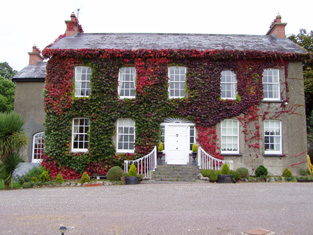
|
| Allowdale | A house valued at almost £12 in the mid 19th century, held by Daniel McCabe from the Earl of Egmont, now a ruin. | |
| Dromagh Castle | In 1815 Smith refers to Mr Philpot inhabiting Dromagh. A seat of the Leader family in the 19th century, Lewis writes that the castle was once the chief residence of the O'Keeffes. In 1906 buildings at Dromagh were valued at £27 and William N. Leader was the occupier. Donnelly states that it was burnt in March 1921 during the War of Independence. It is now a ruin. |
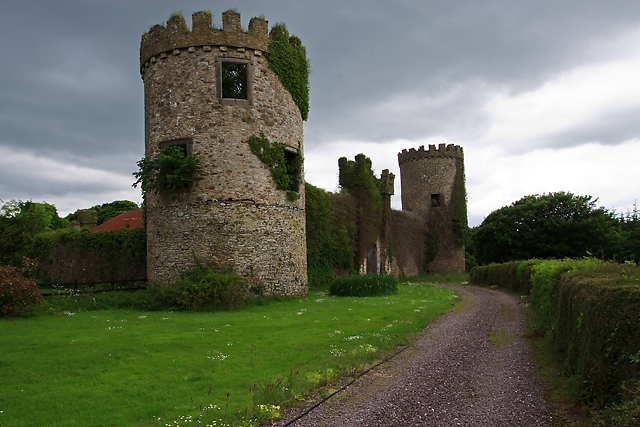
|
| Dysert | A house valued at £12 and held by Nicholas P. Leader in fee at the time of Griffith's Valuation. This house was still in Leader occupation in 1906. A house and farm are still extant at the site. | |
| Fort Grady | Located on the O'Grady, Viscount Guillamore estate, Fort Grady was valued at £14 in the mid 19th century and occupied by John O'Connell. In 1837 Lewis describes it as a farm house formerly the residence of the father of Viscount Guillamore. In 1814 it was occupied by Mr Daniel McAuliffe. In 1786 Wilson refers to it as "Knockbrack, the seat of Mr. Gredy". A house and farm are still extant at the site. | |
| Nashville/Rosnalee | This house was originally known as Nashville and was the home of the family of that name in the 18th century. Wilson refers to it as Nashville, the seat of Mr. Nash, in 1786. It passed by marriage to the Leader family. Nicholas P. Leader occupied the house in 1814. It was still known as Nashville in 1837 but is marked on the first Ordnance Survey map as Rosnalee. Valued at £51 at the time of Griffith's Valuation it was held by William Leader in fee and he had a flour mill nearby valued at £45. The Leaders still occupied this house in 1921. In 1943 the Irish Tourist Association Survey noted it as having been the chief seat of the Leaders, a two-storey spacious structure which was then unoccupied. It is no longer extant. | |
| Ballyphilibeen | A building is marked on the first Ordnance Survey map in this townland. By the time of Griffith's Valuation Prudence Twinhan was living in a house valued at £14 and held from Thomas Wise with 225 acres. | |
| Castlecor | The home of the Freeman family purchased from the Chinnerys in the early 18th century. Smith records it as the seat of William Freeman in 1750 and Wilson describes it as "the fine seat of Mr.Freeman" in 1786. Later the home of the Deane Freeman family who enlarged the building at the beginning of the 19th century. Advertised for sale in 1852, Bence Jones writes that it was bought by Richard Barry. It remained in the Barrys' possession until the 1950s. In the 1940s the Irish Tourist Association survey noted that "the house and offices are now rather neglected". Sold by Mr Hope Murray in the 1960s and subsequently demolished. | |
| Lackeel | An early 19th century house valued at £12 was held by Charles Daly in the mid 19th century from Pierce Purcell. This house is still extant. |
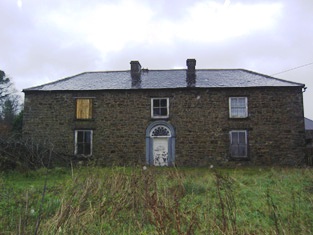
|
| Marybrook | This was originally a tower house with additions from the mid 18th century. Occupied by Edward H. Reardon in the first half of the 19th century and by John O'Connell in the mid 19th century, when it was valued at £11 and held from Bartholomew Gibbings. In the sale rental of May 1860 this house was describes as in "thorough repair" and leased to John Connell for 100 years from 1851. In the 1940s the Irish Tourist Association Survey reported that it was then the residence of the Cronin family. It is still extant and in use. |
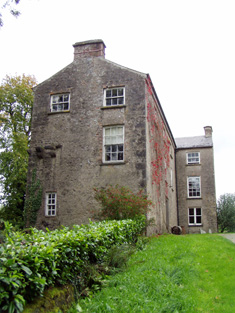
|
| Rossline House | John Noonan held this house valued at £14.15 shillings from Sir Edward Tierney in the mid 19th century. A house and farm are still extant at the site. | |
| Rossline Lodge | Hajba writes that this house was originally built as a hunting lodge for the Earls of Egmont. Patrick Keller held this house valued at £12.10 shillings from Sir Edward Tierney at the time of Griffith's Valuation. It is still occupied. | |
| Castle Park | At the time of Griffith's Valuation this house, valued at £41, was held by Sir Edward Tierney in fee. Still in use as a private residence, in 2014 it was offered for sale. |

|
| Park House | Occupied by Maurice Barry and held from Sir Edward Tierney in the mid 19th century when the buildings were valued at £12+. William F. S. Barry was the occupier in 1906. It is still extant. | |
| Park | A house valued at £18+ in the mid 19th century and held by Sir Edward Tierney in fee. A house is still extant at the site. | |
| Wood View | A house valued at £10+ in the mid 19th century, occupied by Denis McCartie who held it from John McCarthy. The residence of J. McCartie in 1837. In the Irish Tourist Association Survey of the 1940s it is referred to as the residence of Mr. Daly and "formerly the home of the McCarthy-O'Leary family, connected with Daniel O'Connell". The original house is no longer extant. | |
| Killeenleagh | No demesne was marked in this townland on the first Ordnance Survey map but a house valued at £15+ was situated there by the time of Griffith's Valuation. It was occupied by Richard O'Callaghan and held from the Earl of Listowel. | |
| Spring Grove | This house was the home of Arthur Bastable in 1814. This house was part of the Creagh estate for sale in July 1853, Christopher Carleton, "a lunatic", was the leasee. Unoccupied at the time of Griffith's Valuation when valued at £9.10 shillings. The representatives of Thomas Harris were the immediate lessors. A house is still extant at the site. | |
| Roskeen | The home of the Power family which was held from the Kingston estate. Pierce Power occupied the house in 1837 and John Power in the early 1850s when the buildings were valued at £24. Arthur Irwin was the occupier of this house in 1906 and it is still lived in. |
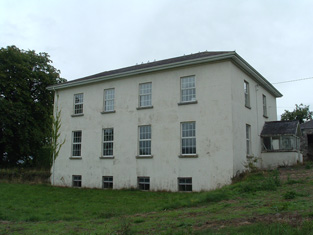
|
| Mountnorth Court | Described by Smith in the mid 18th century as a square building with two wings and fine plantations. In 1786 Wilson refers to it as "the fine and magnificent seat of Lord Lisle, with ample demesnes". This house is described as "in ruins" on the first Ordnance Survey map and modern farm buildings exist at the site now. | |
| Ballythomas | Originally a Crofts home, leased to the Bullen family by the mid 18th century. Occupied by Robert C. Bullen at the time of Griffith's Valuation. He held the house valued at £12+ and 111 acres in fee. The Crofts appear to have resumed possession in the late 19th century. Home of the O'Connors in the 20th century. |
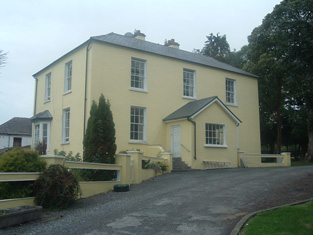
|
| Waterloo | Reputedly built circa 1815 for Henry Longfield, fifth son of John Longfield of Longueville, following his marriage to Mary Powell, heiress of Sea Court, county Cork. At the time of Griffith's Valuation it was held by Henry Longfield in fee and valued at £37. Henry's son John Powell Longfield sold Waterloo to his first cousin Richard Longfield of Longueville who left it to his third son Augustus Henry Longfield. Augustus H. Longfield extended the building. The house was sold to Mr E. W. Hope-Johnstone in 1946. It is still a fine residence. |

|
| Summerville | Originally a Purdon house situated on the Coote estate and described by Smith as a "neat lodge" in 1750. It was home to members of the Chapman and Nason families. Occupied by John Nicholas Wrixon in 1837. Valued at £14 in the early 1850s when it was occupied by Kenny Herbert. Still occupied and surrounded by mature woodland. |
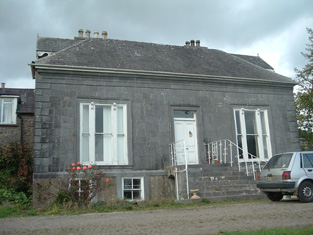
|
| Woodpark | This property belonged to the Wrixon family in the 18th century. In 1814 it was occupied by T. Callaghan. In the mid 19th century James Carmichael was in residence. He held it from the representatives of Charles D. Purcell. The buildings were valued at £11.10 shillings. Hajba writes that the Carmichaels later purchased the property from the Purcells. It is still an occupied residence. | |
| Aldworth | Hajba writes that this house was occupied by members of the Bolster family who held it from the Newmans in the late 18th century. It then became a Lombard property and passed from them to a relative, James Hunt. In the early 1850s it was occupied by James Laurence Cotter, held from James Hunt and valued at £14. This house is still occupied. Another house close by named Aldworth Lodge was also a Bolster home valued at £4+ at the time of Griffith's Valuation. A house is also extant at the latter site. |

|
| Danesfort | According to Hajba built by James Butler Stopford in the very early 19th century, replacing an earlier cottage. Stopford sold his interest to his brother-in-law, Captain Edmund Lombard a few years later. At the time of Griffith's Valuation it was occupied by the Captain's nephew, James Hunt, who held the property valued at £27.15 shillings from Christopher Crofts. In 1944 the Irish Tourist Association survey noted that it was the residence of Stopford Hunt. The house was destroyed by fire in the 1950s. | |
| Clydaville | Mrs Callaghan lived in this houses in 1814 and Mrs Sankey in 1837. Held by Hugh Delacour from Charles Haynes in the early 1850s when the house was valued at £15. The residence of the O'Connor family in the 20th century. Hajba records that the house was demolished in April 2002. | |
| Woodfort | Described in 1750 as "an handsome house, with elegant plantations" inhabited by Simeon Marshal, Surveyor General of Munster. Occupied by Ousley esq in the 1770s and 1780s, this house was the home of Richard Perry in 1814 and of T. Ware in 1837. It was valued at £30 at the time of Griffith's Valuation and still held by Thomas Weir from Charles Haynes. Later the home of the Carroll-Leahy family. In 1944 the Irish Tourist Association survey reported that it was a novitiate for the Sisters of St. Francis. This house now functions as Mount Alvernia Hospital. |

|
| Clyda | Hajba records the building of this house by Charles Haines in 1805. Occupied by Joseph Barry in 1814 and by the Reverend M. Becher in 1837. In the 1850s it was the residence of the Reverend Henry Swanzy who held it from Thomas Haynes. The buildings were valued at £24. Later the home of Lieutenant Colonel Robert D. Perry. In 1944 the Irish Tourist Association Survey noted it as the residence of Mr. Mandeville. In the late 20th century it was owed by the O'Meara family. |
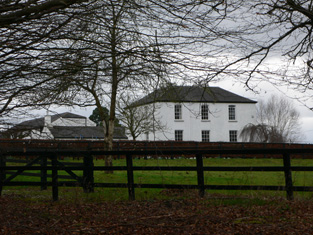
|
| Lombardstown House | The seat for many years of the Lombard family, built in the mid 18th century. In 1750 Smith refers to the house as "lately built by James Lombard". From the 1830s it was leased to the Bolster family. George Bolster held the house valued at £15 plus a demesne of 101 acres from Lady Cotter in the early 1850s. The Bolsters remained in residence until the late 19th century when they sold their interest to Henry G. Smith. His descendants continue to occupy the house (Hajba). |

|
| Fern Hill | Smith records Cornelius Townshend as resident at Betsborough circa 1750. Hajba writes that it was a Townsend property from the early 18th century and birthplace of the United Irishman, Thomas Russell, executed in 1803. The house, on the outskirts of the village of Drommahane, was originally known as Bettesborough (or Besborough) and a Magner occupied a house of this name in 1837. The Reverend Philip Townsend held the house valued at £21+ from William Magner in the early 1850s. In June 1881 the house and demesne of Fernhill were advertised for sale. Barclay Corrie was the owner, holding on a lease dated 1863 from Richard John Perry to Michael Joseph Magnier. The house was demolished in the early 20th century and a new house built on the site. |
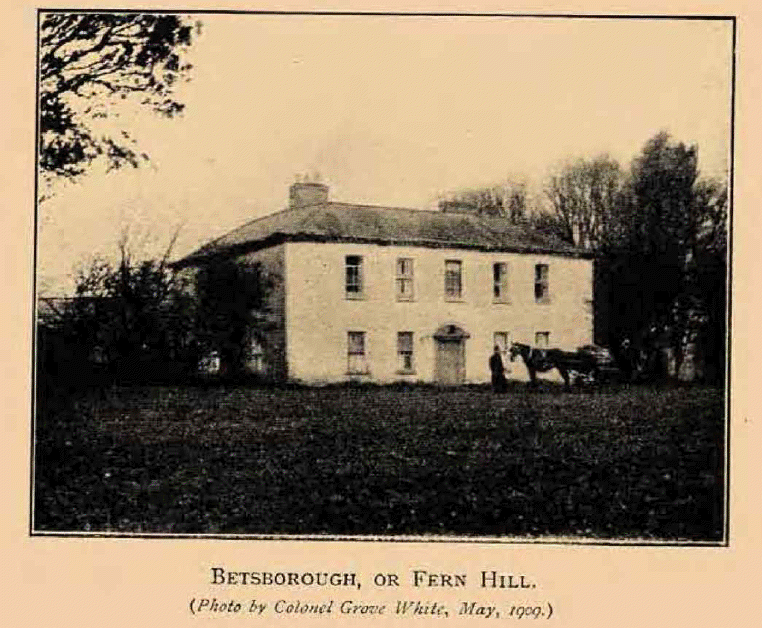
|
| Newberry Manor | This house was the seat of the Newman family in the 18th and 19th centuries. In 1786 Wilson refers to it as "Dromore, the seat of Mr. Newman". The house was valued at almost £49 in the mid 19th century and held by Adam Newman in fee. John R.B. Newman was resident in 1906. The house was burnt in June 1921 during the War of Independence when it was owned by John R. Pretyman Newman. It was rebuilt by the Newmans and then sold to the Poor Sisters of Nazareth as a nursing home. |
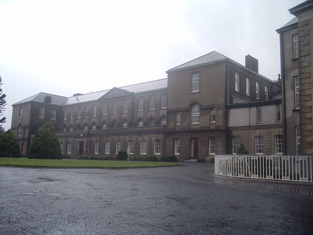
|
| Newberry House | This house was another Newman residence located in the parish of Kilshannig. In 1786 Wilson refers to Newberry as the residence of Colonel Newman, possibly the same man who was murdered in the house by his groom and an accomplice in 1816. John Newman held the property from Adam Newman at the time of Griffith's Valuation. The buildings were valued at £18.10 shillings. Post Griffith's Valuation the house became the home of the Swanzy family and it was they who built the present house incorporating the original one. The house was sold to the Footts in the 20th century. Also known as Kilshannig House. |
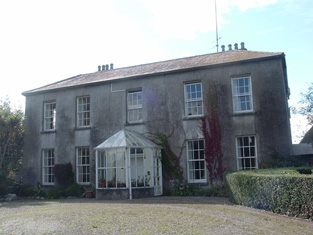
|
| Firville | A home of the Atkins family in the 18th and 19th centuries which in the early 1850s was held from John Clarke with 251 acres. Major Atkins occupied the house in 1814 and R. Atkins in 1837. Hajba writes that the Reverend Philip Atkins-Going left Firville to his unmarried daughters Charlotte and Henrietta when he died in 1861. Hussey de Burgh records Mrs Charlotte Henrietta Atkins of South Mall, Cork, owning 502 acres in the 1870s. Sold to Samuel Sheehan in 1914 this property still belonged to his descendants at the beginning of the 21st century. |
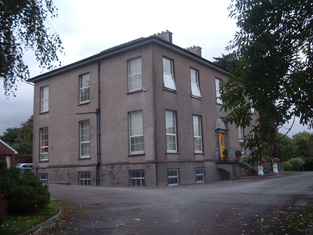
|
| Eden Hill | Situated on the Longfield estate and occupied by John Crosbie who held the house valued at £19.10 shillings from Joseph Carpenter. The Carpenter resided here from the late 18th century. Thomas Carmichael bought Carpenter's interest and advertised the sale of Eden Hill house and demesne in December 1856. Later the home of the Guerin family and in the late 20th century of the O'Callaghan family. |

|
| Ballyclogh Castle | At the time of Griffith's Valuation Thomas Haines and Son owned a house, corn and flour mill and offices in the townland of Ballyclogh valued at £82. This property was held with 4 acres from the representatives of C.P. Coote and John Wrixon. In 1906 Ballyclogh was occupied by the representatives of Charles P. Coote. The house was located adjacent to a medieval tower house. Both the house and mill are now in ruins. | |
| Blossomfort | Hajba refers to John Wrixon of Blossomfort in 1703. Wilson, writing in 1786, refers to Blossom-fort as the seat of Mr. Wrixon. The present house, occupied by William Bullen in 1814 and by J. Smith in 1837 was built by the Wrixons probably in the early 19th century. In the mid 19th century Blossomfort was the residence of Thomas Haynes who held the property from Benjamin Wrixon. It was valued at £14. Sold by the Wrixons to the Longfields of Longueville, Blossomfort became the residence of their agent, Richard Smith. This house was reconstructed following a fire in the early 1900s and is still extant. |
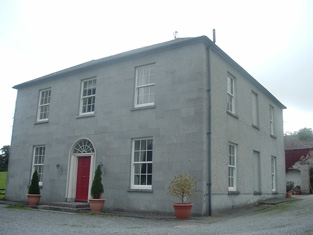
|
| Cecilstown Lodge | A home of members of the Wrixon family in the late 18th and early 19th centuries. Occupied by William Wrixon, father of Sir William Wrixon Becher, in 1837. It was leased to Thomas Heffernan from the 1840s. Valued at £9 in the early 1850s it was later occupied by members of the clergy including the Reverend E.G. Jones, whose widow bought the house in the early 20th century. It was burnt in June 1921 during the War of Independence when it was the residence of the sisters, Esther Jane and Annie Jones. A house, however, still exists at the site. | |
| Dunbarry | This house was the home of James Carey in 1814. Occupied by James Heffernan and held from Sir Edward Tierney at the time of Griffith's Valuation, valued at £18. Sold by the Heffernans in the early 20th century, this house is still extant. The Irish Tourist Association survey mentions Dunbarry as the residence of Denis Kiely in the 1940s. | |
| Tullig | Tullig, located on the Tierney estate and valued at £15.15 shillings, was occupied by Richard Hutch in the early 1850s. The Irish Tourist Association Survey noted that it had belonged to Lord Broghill before the 1641 rebellion and was later granted to the Percevals. It was the residence of John Waterson in the 1940s. It is no longer occupied. |

|
| Gubleagh House | The buildings at Gubleagh House, Annagh South were valued at £13 at the time of Griffith's Valuation and the house was occupied by Johanna Cowhy who held it and 189 acres from Sir Edward Tierney. This house is still occupied. | |
| Burton Park | The original house built by Sir John Perceval and his descendants was burnt down in the Jacobite War 1689-1691. A late Georgian house was built to replace it by the [3rd or 4th] Earl of Egmont which was remodelled in the late 19th century. Burton Park was leased to the Purcells in the 19th century. It was occupied by the Reverend Matthew Purcell in 1814 and 1837 and by his son John in the early 1850s when the house was valued at £34. Passed to the Ryans of Scarteen, county Limerick by marriage in the early 20th century. In the 1940s the Irish Tourist Association Survey noted Burton Park as one of the best examples of eighteenth century domestic architecture in county Cork. Still the home of the Ryan Purcell family. |

|
| Clashganniv | Hajba writes that this house has always been the home of the O'Brien family. Vincent O'Brien, the famous Irish race horse trainer, was born at Clashganniv in 1917. The house is still extant and occupied. At the time of Griffith's Valuation there were two houses in Clashganniv, one valued at £16, was occupied by James Lynch and the other valued at £10 was held in fee by Sir Edward Tierney. | |
| Creggannacourty | Cregane House in Creggannacourty was occupied by the representatives of Sarah Barry and held from Sir Edward Tierney at the time of Griffith's Valuation, when the house was valued at £35. Hajba associates the names Crofts, Hennessy and Hutchins with the house, which in 2002 was the home of the Lynch family. |

|
| Mount Corbitt | Home of the Glover family in the first half of the 19th century. Hajba writes that the Glover's sold their lease to the Anderson family in the early 1850s. In the early 20th century it became the home of the O'Brien family and is still occupied. |

|
| Rath | Smith writes in 1750 that Rath was built by Alderman James French of Cork. Rath house was occupied by Michael Greene in the early 1850s and held from Sir Edward Tierney. It was valued at £12. To the north Rath Cottage (Grid Ref R492 147) was held by Sir Edward Tierney in fee and was valued at £14. This cottage is now a ruin and Rath House although still extant is no longer lived in, a new house having been built on the site. | |
| Walshestown | This townland was leased to Robert Conron early in the 18th century by Sir Philip Perceval. By 1814 the house was occupied by John Wrixon. Hajba writes that he was the son of Edward and Anne Wrixon. In the early 1850s Nicholas Wrixon was resident holding the house valued at £8 from John Wrixon. In the 1830s the house is recorded as being occupied by George Crofts and his wife Eliza Purcell of nearby Burton Park. George Crofts was a brother of the Reverend F.W. Crofts. This house is no longer occupied. |

|
| Jordanstown | A house valued at £14 was occupied at Jordanstown by James Buckley at the time of Griffith's Valuation and held from Sir Edward Tierney. Hajba writes that the Buckleys continued to live at Jordanstown for the rest of the 19th century. Sold to Patrick Walshe in the early 20th century this house is no longer occupied. |

|
| Liskelly | This house situated on the Egmont estate was occupied by Richard Gregg in 1814 and in the early 1850s by David Coghlan who held the house valued at £12 from Sir Edward Tierney. Later Liskelly became the residence of the Nagles and the Brownes. It is no longer occupied. | |
| Bregoge House | A house reputed to incorporate the remains of an old castle. Bregoge Castle was occupied by J. Rogers in 1837 and by John Rogers in the early 1850s. The property was held from the Earl of Egmont and the buildings were valued at £7. The Irish Tourist Association survey in the 1940s notes it as the residence of "Mr.Ryan, a commercial traveller". The house is still a family home. |

|
| Glenville | At the time of Griffith's Valuation Mary Allen occupied Glenvillle, a house valued then at £8. The property was held from the Earl of Egmont. Catherine Cooke daughter of William Allen of Glenville married John Bevan of Camas in 1856. Hajba writes that Glenville belonged to Massy Bevan in the late 19th century. The house was restored in the 20th century and is occupied. |

|
| Rathclare | Clare Cottage was originally a residence on the Egmont estate which Hajba writes was leased to the Norcott family. Occupied by Martha Bullen in the early 1850s when the house was valued at £13. A much larger house was constructed in the mid 19th century incorporating the original building. By the end of the 19th century the home of the Burdon family who were still resident in 2002. In 2012 it was being offered for sale. |

|
| Ardenville | A single storey house possibly built for the heir to the Egmont title, Baron Arden, to reside in before succeeding to the title. At the time of Griffith's Valuation it was occupied by James Norcott and valued at £11.10 shillings. Recently extended and still occupied. | |
| Spitalfields | Dating from the mid 18th century, Hajba writes that this house was built by Christopher Waggett, nephew and son-in-law of George Crofts of Velvetstown House. By 1814 it was occupied by Richard Purcell and at the time of Griffith's Valuation by Fitzgerald O'Keeffe who held it from the Earl of Egmont. It was valued at £20+ at this time. In the 1870s George Crofts Harris of Spittalfields owned 591 acres in county Cork. The property of the O'Brien family in the 20th century, run as a guest house. |

|
| Egmont House | An early Perceval house situated at Egmont was replaced by the present house in the 18th century. At the time of Griffith's Valuation John Bolster was occupying Egmont House on the Egmont estate. The buildings were valued at £15. Later leased to the Lynch family. The house is extant and under refurbishment in recent years. |

|
| Egmont Lodge | A house was in existence at this location at the time of the first Ordnance Survey but is not named on the map. By the time of Griffith's Valuation it was valued at £14 and occupied by Bartholomew W. Purdon. It is labelled Egmont Lodge on the 25-inch Ordnance Survey map of the 1890s. A house is still extant at the site. |

|
| Egmont Cottage | Egmont Cottage is marked on the first Ordnance Survey map circa 1840. It was the single storied residence of Margaret Magrath in the early 1850s. She held the property from the Earl of Egmont and the buildings were valued at £10. The building has since been extended and is still occupied. Hajba calls this house Egmont Lodge. |

|
| Fort Moylan | Home of the Moylan family on the Egmont estate, occupied by Cornelius Moylan at the time of Griffith's Valuation when the buildings were valued at £10. Still extant and occupied |

|
| Buttevant Castle | Originally a castle of the Barry family, Earls of Barrymore, sold by them in the early 19th century to John Anderson of Fermoy, who restored it as a castellated house and gave it to his eldest son Sir James Anderson. Sir James lived there until the mid 1840s. William Roche occupied the building valued at £37 in the early 1850s. He held the property from Viscount Doneraile and D.R. Browning held a house, flour mill and offices valued at £120 from Roche. The castle had various occupants in the later 19th century and was last occupied in the early 20th century. It is now a ruin. |

|
| Castle View | Located on the Doneraile estate in the mid 19th century this house was occupied by Barry Gregg in 1837 and by the Reverend Cornelius Burkley in the early 1850s when it was valued at £28. This 18th century seven bay house is still a family residence. |
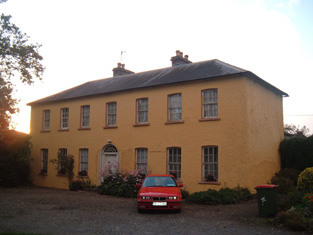
|
| Springfield | The seat of the Norcott family in the 18th and 19th centuries, occupied by Hugh Norcott in 1814 and by James Norcott at the time of Griffith's Valuation when the buildings were valued at £18. The property was held from the Viscount Doneraile at this time. Sold to the Davisons in 1908, it remained in their possession for much of the 20th century. The house is still occupied. |

|
| Velvetstown | Seat of the Crofts family for over three centuries, "Velvex-town" was occupied by Thomas Crofts in 1814, by T. Lucas Crofts in 1837 and by Reverend William Crofts in the early 1850s. Reverend William held the house and 708 acres from Penrose Fitzgerald and the buildings were valued at £21. Hajba writes that the original house was replaced by an elaborate Italianate mansion in the late 1870s but when this burnt down in 1895 they moved back into their old home. She also writes that Velvetstown is one of the few North Cork houses still occupied by the family that built it. The Irish Tourist Association survey noted in the 1940s that the walls of the Italianate mansion were still standing though the chimneys had been taken down. |

|
| Templemary | A house located on the Purcell estate, occupied by Purcell esq in the 1770s and 1780s, by John Purcell in 1814, by J. O'Leary in 1837 and by Kilner R. Woods in the early 1850s who held it from Wills George Crofts. The house was valued at £23+ at this time. The Fuges occupied the house in the late 19th century and early 20th century. The house was valued at £26 in 1906. The Irish Tourist Association survey in the 1940s described it as "a spacious three-storey house with a cellar". A new house now stands on the site. | |
| Kilpatrick | Hajba writes that Roger Langley leased this property from the Longfields in the mid 18th century. Lewis writes that William J. McCormick, medical doctor,occupied the house in 1837. A boys' school was established at Kilpatrick by the McCormicks. At the time of Griffith's Valuation William J. McCormack held the house valued at almost £10.15 shillings from Christopher Langley. Sir William J. MacCormac was a well known London surgeon, the son of Dr Henry MacCormac of Belfast. The house was occupied until the early 20th century but is now a ruin. | |
| Currymount | Lewis gives J. O'Leary as the proprietor of Currymount in 1837. By the time of Griffith's Valuation Currymount was held by Alexander McCarthy in fee and was valued at £7.10 shillings. Hajba writes that Alexander McCarthy left Currymount to his brother-in-law, James Morrogh, third son of James Morrogh of the city of Cork. The house was considerably extended post Griffith's Valuation. James McCarthy of Currymount owned 259 acres in the 1870s. In the late 19th century Eustace Morrogh Bernard lived at Curraghmore. Bought by the Purcells of Burton Park in the second decade of the 20th century as a dower house and passed by marriage to the Bird family. The Irish Tourist Association Survey refers to it as the seat of Major Bird in the 1940s and also that the Morrogh-Bernard family resided here before going to live at Byblox. |

|
| Fortwilliam | A house on the Evans estate occupied by William Barry at the time of Griffith's Valuation when it was valued at £23, later a Sheehy residence. The Sheehy sale rental of 1875 records the house containing 3 reception rooms and 5 bedrooms. It was conveyed to Robert K. Sheehy by Edward R. C. Barry on 7 January 1874 and advertised for sale in June 1875. The National Inventory of Architectural Heritage dates this Tudor Revival house from circa 1880 to the design of Sir John Jackson (1851-1919), so the present house may incorporate the earlier one which is marked on the first Ordnance Survey map. In 2006 this house was no longer occupied. |
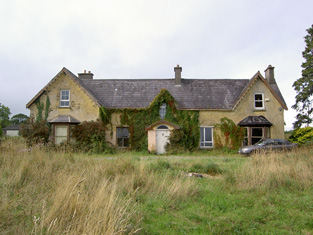
|
| Prohust | Prohust/Prohurst/Proughis was built by Jonathon Bruce, third son of the Reverend Jonathon Bruce of Milltown Castle, and occupied by him in 1837. By the time of Griffith's Valuation the property was held by George and John Evans in fee, the buildings were valued at £37. Hajba writes that the house was occupied by members of the Turner and Rice families in the latter half of the 19th century. This house is still occupied. |
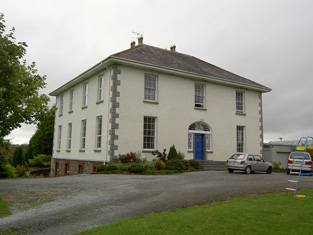
|
| Altamira | Originally a Smyth house, Altamira became the home of the Purcell family in the late 18th century and remained in their possession for about a century. Occupied by William Purcell in 1814 and 1837 and by his nephew Pierce Purcell at the time of Griffith's Valuation. Pierce held the property from the Earl of Bandon and Lady O'Brien. The house was valued at £34. In the 1940s the Irish Tourist Association Survey noted that Altamira was then the residence of the Hannigan family. |
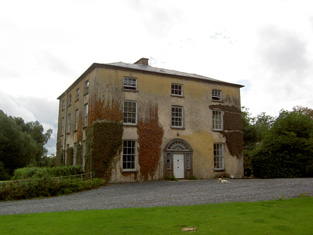
|
| Millfort | This house was the home of the Foote family in the 18th century as Wilson refers to it as the seat of Mr. Foote in 1786. At the time of Griffith's Valuation the house was valued at £4.10 shillings, occupied by William Upplington and held from the representatives of George Foot. It appears to have fallen into ruin by the time the 25-inch Ordnance map was published in the 1890s and no trace remains now. | |
| Springfort Hall | A branch of the Foott family were resident at Springfort from the early 18th century. The house was occupied by James Foot in 1814 and by [his grandson] another James Foote in the early 1850s, who held the property from the Earl of Limerick. Hajba writes that Springfort Hall was bought by Charles W. Wyatt in 1854 and sold again four years later to Captain Spencer Stewart, a grandson of the 7th Earl of Galloway. Springfort remained in the possession of the Stewart family until the beginning of the 20th century. It was leased to Commander Hans Thomas Fell White in 1895. It now functions as a country house hotel. |

|
| Elmvale | Elmvale was occupied in 1814 by Henry Lysaght and by 1837 was in the occupation of J. Duggan. Arthur Duggan held the property from the Earl of Limerick in the early 1850s. The house was valued at £20. Hajba writes that in the early 20th century the house was purchased by Sidney Royse Lysaght and following a feud with a neighbour was burnt in 1917. Later rebuilt and still occupied. |

|
| Pencil Hill | This house was built in the 1780s by Harmer Spratt who had married a member of the Foott family. It was known as Monte Video in 1837. The Spratt continued to live in the house untill the early 20th century when it was sold to the Perrott family. The Perrotts changed the name of the house to Beechfield and it was still the home of this family at the beginning of the 21st century. | |
| Clogheen | In his journal William Lysaght refers to building a cottage at Clogheen in 1749. He was leasing Clogheen from Lady Midleton [see De Breffny, page 115]. By 1814 Clogheen was occupied by Arundel Hill who was still resident in 1837. Reverend William F. Crofts was the occupier at the time of Griffith's Valuation. He held the property from William Lysaght. It was valued at £31. In 1870 the house was occupied by Mrs Ellen Crofts. This house no longer exists although the outbuildings still stand. | |
| Hazlewood | ''Burke's Irish Family Records'' suggests that this was originally an Atkins property which came into the possession of the Lysaghts through marriage. Hajba writes that William Lysaght built the house following his marriage in 1819 to Frances Atkins. Colonel Grove White's notes state that it was built before the marriage. In 1837 it was occupied by William Lysaght and in the early 1850s by Carbery B. Egan who held the property from William H. Lysaght. The buildings were valued at £21. This house remained in Lysaght posssession throughout the 20th century having been sold in 1913 by William Lysaght to his first cousin, Sidney Royse Lysaght. In the 1940s the Irish Tourist Association Survey noted that it was famous for its plant nurseries. |

|
| Kilburn/Kilbyrne | The White family resided at Kilburn from the early 18th century to the mid 20th century. The original building was replaced by a new house built in the late 1820s. This building was valued at £35 in the early 1850s. From 1903 to 1938 this house was the home of Colonel James Grove White who compiled the work ''Historical and Topographical Notes on Buttevant, Castletownroche, Doneraile and Mallow.'' The house was partly demolished in the mid 20th century. | |
| Rockfield | A Nash home in the first half of the 19th century, occupied by Christopher Nash at the time of Griffith's Valuation and held from John James Nugent. The buildings were valued at £7. In the 1940s the Irish Tourist Association Survey noted that this property had once belonged to a family called Badham but was afterwards acquired by the Nashs and that "the present house was probably built by the latter family". A house and substantial farm are still extant at Rockfield. | |
| Ballyellis | Ballyellis was occupied by Edmund Barry in 1814 and by Henry Langley at the time of Griffith's Valuation. H. Langley held the property from James Barry and the buildings were valued at £12. It later came into the possession of the Harold Barry family and members of the family were still resident at Ballyellis at the beginning of the 21st century. |
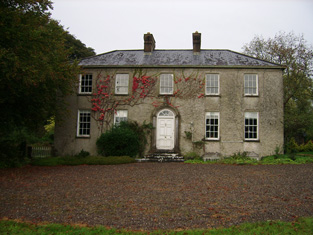
|
| Woodville | Built as a shooting lodge for the Holmes family, occupied by Richard Sherlock in 1814 and by Captain William Harrington Sherlock at the time of Griffith's Valuation and bought by him in the Encumbered Estates' Court. His daughter married George Washington Brasier Creagh and the house remained in her possession until the 1920s. It is now a Crofts residence. | |
| Ballyhoura Lodge | Ballyhoura Lodge was occupied by Christopher Crofts at the time of Griffith's Valuation. He held the property from the representatives of Robert Holmes and the buildings were valued at £23. The house is still a family home. |
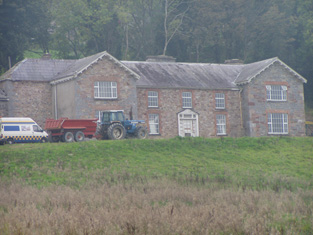
|
| Fairy Hill | At the time of Griffith's Valuation Robert De La Cour was resident at Fairy Hill, which he held from the Earl of Limerick. The buildings were valued at £36. Hajba writes that Robert lived in this house from circa 1817 to 1878. The property then passed to his niece, Miss Herrick of Shippool, who married William Nicholas Wrixon Becher in 1888 and this couple lived at Fairy Hill. Fairy Hill was in use as a nursing home at the beginning of the 21st century. | |
| Annabella House | Smith records Courthorp Clayton as resident at Anabell in 1750. The Hoares were resident at Annabelle in the late 18th century as Wilson refers to it as the seat of Mr. Hoare in 1786. The house was occupied by Richard Harris Purcell in 1814 and in 1837 and by Elizabeth Purcell at the time of Griffith's Valuation. She held the property from the Earl of Limerick and the buildings were valued at £35. This house was demolished in the latter half of the 19th century and the County Council office now stands on the site. | |
| Hawthorn Cottage | Occupied by Mrs Ellen Lombard at the time of Griffith's Valuation when the property was held from the Earl of Limerick and valued at £15. |

|
| Sunny Hill | In 1786 Wilson refers to a seat of Mr. Cotter in the town of Mallow. James Delacour, second son of Robert Delacour of Beare Forest, was residing at Sunny Hill in the mid 19th century. He held the property from Henry Braddle and it was valued at £36. He was still described as "of Sunny Hill" in 1886. The house became a rectory for about fifty years in the 20th century. In 1942 the Irish Tourist Association Survey referred to it as "a fine well kept residence built by J. Carmichael". It is now a private residence named Duarrigle. | |
| Garland Cottage | Occupied by Anne Davis and held from Henry Braddle at the time of Griffith's Valuation. The buildings were valued at £25. Hajba writes that it was the home of the Davis family for most of the 19th century. Bought by James John Dudley in the 20th century, father in law to Erskine Childers, President of Ireland. |
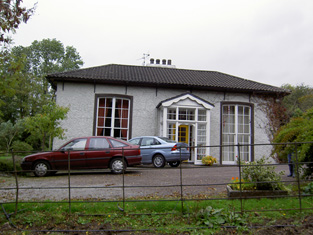
|
| Ballyviniter | A Stawell residence in the 18th and 19th centuries, occupied by George C. Stawell in the early 1850s, when the buildings were valued at £15. Stawell held the property in fee. The original house is not extant. | |
| Bearforest | Named after Richard Beare who held this land in the early 18th century, the house was built in 1807-1808 by Robert Delacour, a partner in the Delacour bank of Mallow. Townsend writes that it was designed by Richard Morrison. Delacour was living in the house in 1814 but had vacated it by 1837. At the time of Griffith's Valuation it was occupied by John Hugh Bainbridge who held it from James Murphy. The buildings were valued at £70. Bence Jones records the Purdon Coote family as later owners. The house was burnt in June 1921 during the War of Independence when it was the residence of Maj. Charles Purdon Coote but was rebuilt. |

|
| Carhookeal | This house was also known as Mount Watts and Castleview. It was the home of the Williamson family for most of the 19th century. Occupied by Arthur Williamson in the early 1850s and held by him from Richard Barrett. The buildings were valued at £22. Occupied by Colonel R. F. Williamson in 1906. The Irish Tourist Association Survey in 1942 noted that it used to have a third storey and that it was then unoccupied. The National Inventory of Architectural Heritage notes its use as a GAA clubhouse in this century. |
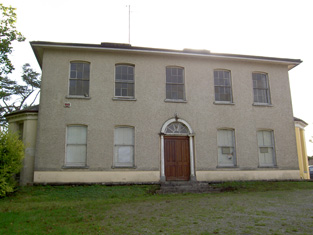
|
| Summerhill | Originally a Stawell home, Wilson refers to Summer-Hill as the seat of Mr. Stawell in 1786. It was occupied by John Stawell in the early 1850s and held from John Guinness. The buildings were valued at £18.10 shillings. Sold in 1853 to Major General Usher Williamson. The house remained in Williamson possession until the 20th century. The Irish Tourist Association Survey in 1942 recorded that it had been purchased and was resided in, by the Buckley family at that time. It is still a family residence. |
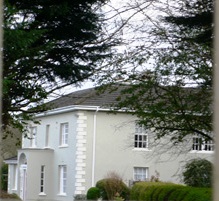
|
| Mallow Castle | Originally a Fitzgerald stronghold, the Jephsons lived at Mallow from the early 17th century until the late 20th century. The castle was abandoned in the late 17th century and the stables converted into a dwelling house. This building was extended by the Jephsons in the 18th century and Wilson, writing in 1786, states "the seat of Denham Jephson which is greatly deserving of the notice of a traveller". Lewis refers to the rebuilding of the castle in 1837 by Sir Denham Jephson. At the time of Griffith's Valuation the buildings were valued at £80. Slater refers to it as the residence of Miss Norreys in 1894. In 1942 the Irish Tourist Association Survey noted that the building had a fine library. Mallow Castle was sold by the Jephsons in 1984. |
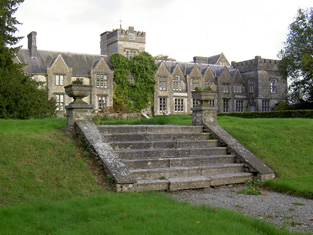
|
| Cortigan | A house on the Jephson estate, probably used as a dower house or agent's residence. At the time of Griffith's Valuation the buildings were valued at £10 and Sir C. D. Jephson Norreys is recorded as occupier. This house was not in use at the end of the 20th century. | |
| Rough Hill | The home of the Harmon family from the late 18th to the late 19th century. At the time of Griffith's Valuation Samuel Harman occupied the house valued at £12 and held from Sampson French. Buildings are still extant at the site. | |
| Sunnyside | Richard Barrett occupied a house valued at £15 which he held in fee. Hajba writes that Charles H. Haines built this house named Sunnyside in 1862. He was leasing the townland from Richard Barrett. The National Inventory of Architectural Heritage dates the house circa 1820. The home of the Cashman family in the 20th century. |

|
| Gooldshill | At the time of Griffith's Valuation Henry Goold was leasing land in the parish of Mallow to Michael Jones. Gooldshill was occupied by Edmund Roche who held the house and 7 acres from Michael Jones. The buildings were valued at £12. Hajba writes that this house is now derelict. | |
| Aughrim | A home of a branch of the Goold family occupied by George Goold in the early 1850s and held from Henry V. Wrixon. The buildings were valued at £13.10 shillings. George Goold still lived here in the 1870s. The house is occupied. | |
| Quartertown House | A Dillon residence in the mid 18th century, passed by marriage to the Crokers. Wilson, writing in 1786, refers to it as the seat of Mr. Dillon. The Crokers also owned the mills nearby. Occupied by John D. Croker at the time of Griffith's Valuation and held by him in fee. The buildings were valued at £40. Later bought by the Webb family. In 1942 the Irish Tourist Association Survey mentioned that it was then let to the Nazareth Sisters. It is now in ruins. | |
| Wilton | Valued at £15 at the time of Griffith's Valuation and held by James Welply from John D. Croker. Later occupied by Bradys, Westropps and Webbs, still extant. |
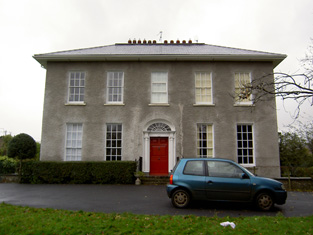
|
| Killetra [Mount Ruby] | Hajba writes that this house, originally known as Mount Ruby, derived its name from the Ruby family who lived there in the mid 18th century. Thomas Flynn, Justice of the Peace for Cork in 1793, married a Ruby. In 1786 Wilson refers to "Kilottery" as the seat of Mr. McCarthy. The house had a number of occupants, including John N. Wrixon, before it became the residence of Michael Jones at the time of Griffith's Valuation. It was valued at £18 and held from the representatives of Thomas Flynn. This house is still a family residence. | |
| Beechmount | At the time of Griffith's Valuation Sackville Hamilton occupied this house, valued at £22, which he held from James Lysaght, third son of William Lysaght of Fort William and Catherine Royse. James's son, William Lysaght, later lived in this house, which is still occupied. Sold to the Verlings in 1870. | |
| Teeveeny House | A house valued at £14 held by Michael Cagney from Richard and Jonas Morris in the mid 19th century. His widow Johanna Cagney was still resident in the 1870s. In 1943 the Irish Tourist Association Survey reported that the house had was then occupied by the Condron family. Buildings are still extant at the site. | |
| Moyge | Richard Boles was granted Moyge in 1666. Sir Bernard Burke records the Boles of Devon as still having an interest in Moyge in 1850. At the time of Griffith's Valuation Maurice Newman [Nunan] was the occupier holding the property from the Earl of Bandon. The buildings were valued at £10. 10 shillings. This house no longer exists. | |
| Clonmeen House | Built in 1893 for Stephen Grehan and designed by George Ashlin. This house remained in the possession of the Grehan family until the 1970s. In the 1940s the Irish Tourist Association Survey noted it as the residence of Major Grehan. Late in the twentieth century it functioned as a hotel for some time but has now returned to private ownership. |

|
| Clonmeen Lodge | Hajba writes that this house was the home of Cornelius O'Callaghan in 1750. In 1786 Wilson refers to "Bantyre" as the seat of Mr. Callaghan. Viscount Lismore is recorded as proprietor of Clonmeen in 1814. At the time of Griffith's Valuation Clonmeen Lodge was occupied by George Grehan and held from Viscount Lismore. It was valued at £7+. The Grehans continued to use this house as a secondary residence while their main residence was in Dublin. In 1893 a much larger house, Clonmeen House, was built close to the lodge. In the 1940s the Irish Tourist Association Survey noted "The Lodge, Banteer" as the residence of Jerome O'Callaghan and stated that the house had originally been built by the Nash family as a fishing lodge. A building is still extant at the site. | |
| Highfort | The Purcells originally lived in a thatched house located a short distance from the present building and this house was associated with a Whiteboy attack. John Purcell was knighted for his defense of his property. The later house was built by his son, Dr. Richard Purcell, circa 1837 and Dr Richard's wife, Mrs Eliza Purcell, was resident in the early 1850s when the house was valued at £21+ and held from Pierce Purcell. Mrs Eliza Purcell was the second daughter of Pierce Purcell of Altimira. Occupied by Daniel Stephen Wigmore in the early 20th century. The Irish Tourist Association Survey of the 1940s noted that it was then the residence of the O'Sullivan family. It is no longer extant. | |
| Springville | Originally owned by a family named Minton who sold the property to the Wises of Cork city in the 1840s. It was then leased to Charles Daly who occupied the house valued at £5 at the time of Griffith's Valuation. Grove White writes that Daly spent a large sum of money reconstructing the house. Later occupied by O'Briens and Bolsters, still extant and lived in. |

|
| Cahermee | A late 17th century house belonging to the Freeman family, passed by marriage to the Hewson family. A Hewson relative John Milward was resident in 1814. Occupied by John Kearney and held from John Hewson at the time of Griffith's Valuation, when the buildings were valued at £8.5 shillings. Hajba writes that Margaret, daughter of William Hewson Kearney, inherited the house and she married Michael Carroll. This house is no longer occupied. |

|
| Copsetown Abbey | This building is named Fitz Urse Lodge on the first edition Ordnance Survey map. It was valued at £6 occupied and held in fee by Richard Beere in the mid 19th century. Hajba writes that William Fitzgibbon, a Cork draper, bought the house in 1851 and that it was the home of the O'Connors in the 20th century. The house was known as Copsetown Abbey by the end of the 19th century. |
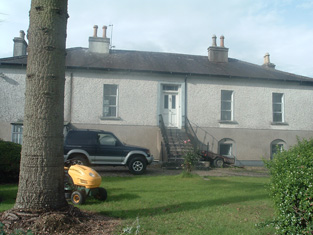
|
| Farm Hill | In the mid 19th century occupied by Mrs Hannah Goold, valued at £13 and held from Richard and Jonas Morris. This house is marked on the first Ordnance Survey map and a building is still located at the site. | |
| Glenview Cottage | In 1786 Wilson refers to a house in the vicinity of Egmont as "Glenfield", the seat of Mr. Wrixon. This may be the property marked on the 1st edition Ordnance Survey map as Glenview Cottage. At the time of Griffith's Valuation, this house was leased by Daniel Murphy from the Egmont estate and valued at £10. A house is still extant at the site. | |
| Holmesfort | In the 1940s the Irish Tourist Association survey notes that a house at Shinanagh, parish of Imphrick, was occupied by Major Thomas Holmes in the early nineteenth century and known as Holmesfort. It was replaced in the 1830s by another house, built by an O'Connor family. By the 1940s it had become the home of the O'Regan family. A house and farm buildings are still extant at the site. | |
| Gortmore Cottage | At the time of Griffith's Valuation, Gortmore Cottage was occupied by Roger O'Callaghan, leasing from Reverend Phillip Townsend, when the house was valued at £11. In the 1940s the Irish Tourist Association Survey noted that the original house had burnt down in 1911 and a two-storey house was then occupying the site. | |
| Mount Ruby | In 1942 the Irish Tourist Association Survey noted a house known as Mount Ruby which had been built by Arthur Gethin Creagh, c.1903-04. Its title echoes the name of another house in the same townland which has been known since the eighteenth century as Killetra House but which was originally called Mount Ruby. The twentieth century house, built in the Arts-and-Crafts style, is also still extant and occupied. |
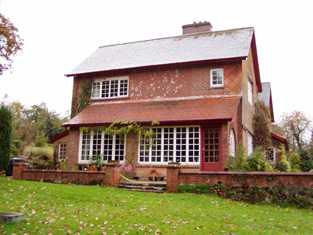
|
| Mount Pleasant (Duhallow) | At the time of Griffith's Valuation, James L. O'Keeffe was leasing a property valued at almost £4 from Manus O'Keeffe. This appears to be the house shown on the 25-inch Ordnance Survey map of the 1890s as Mount Pleasant. It is still extant and in 2014 was offered for sale. |

|

